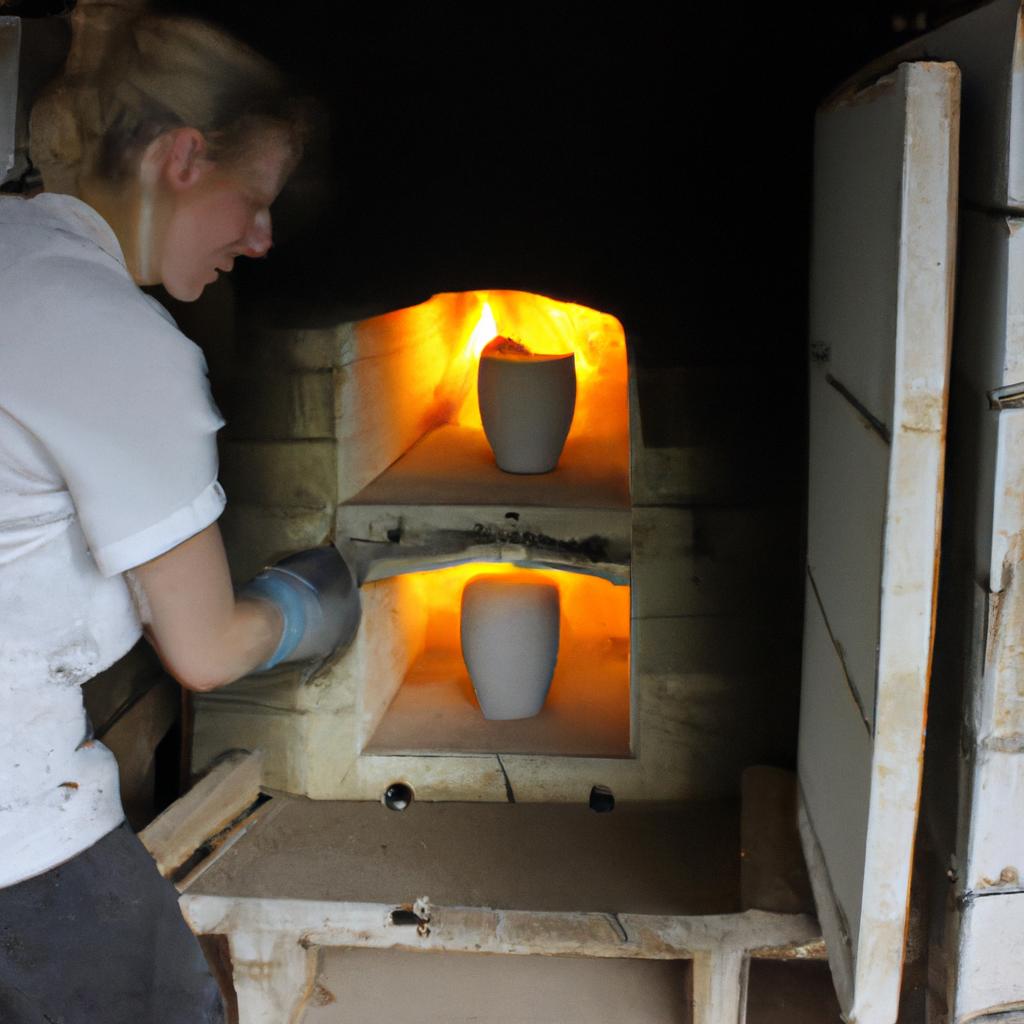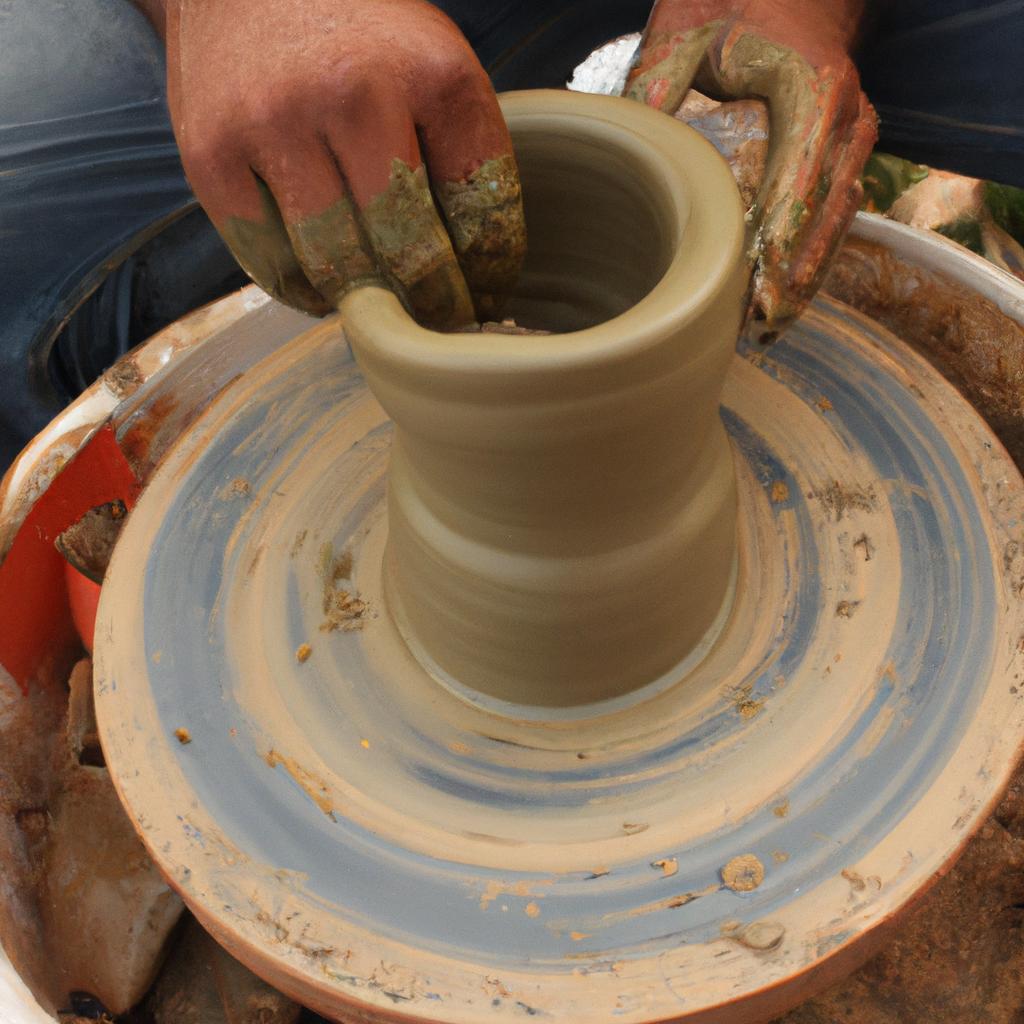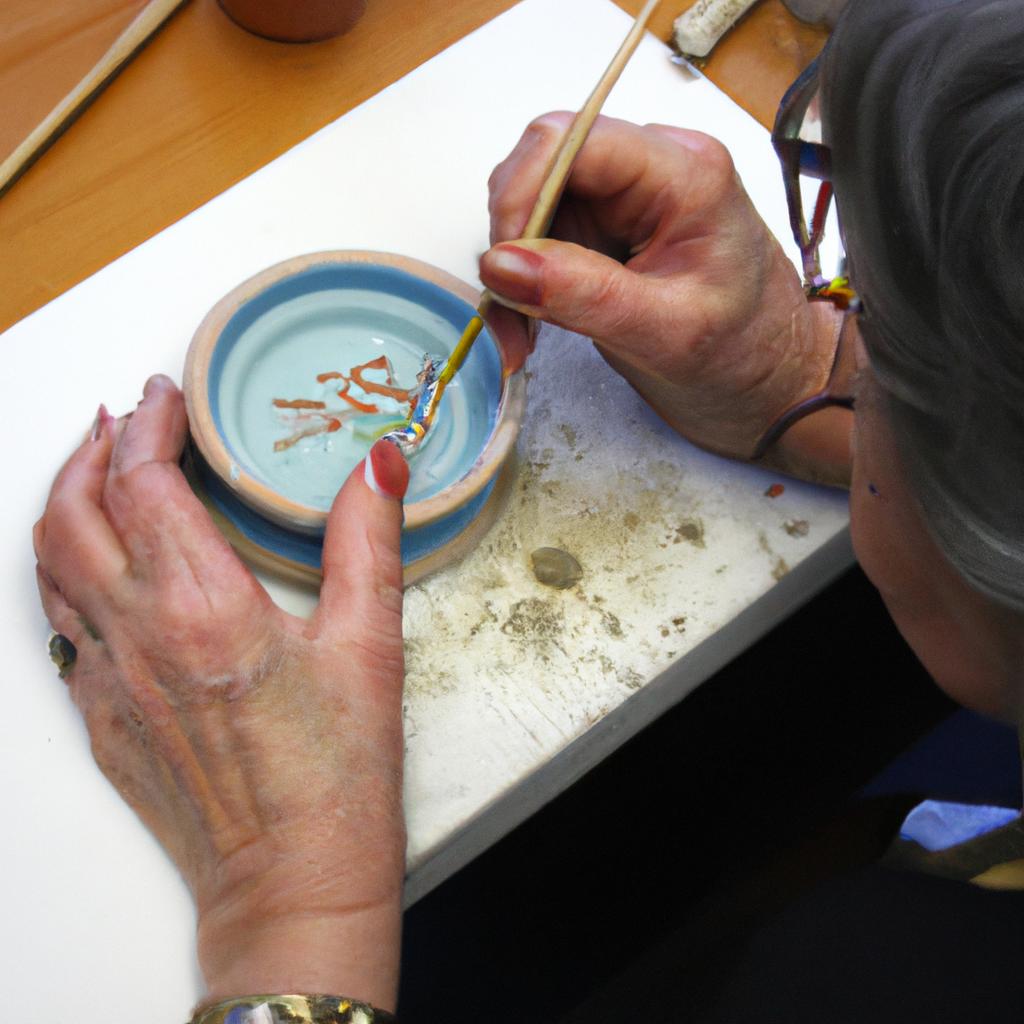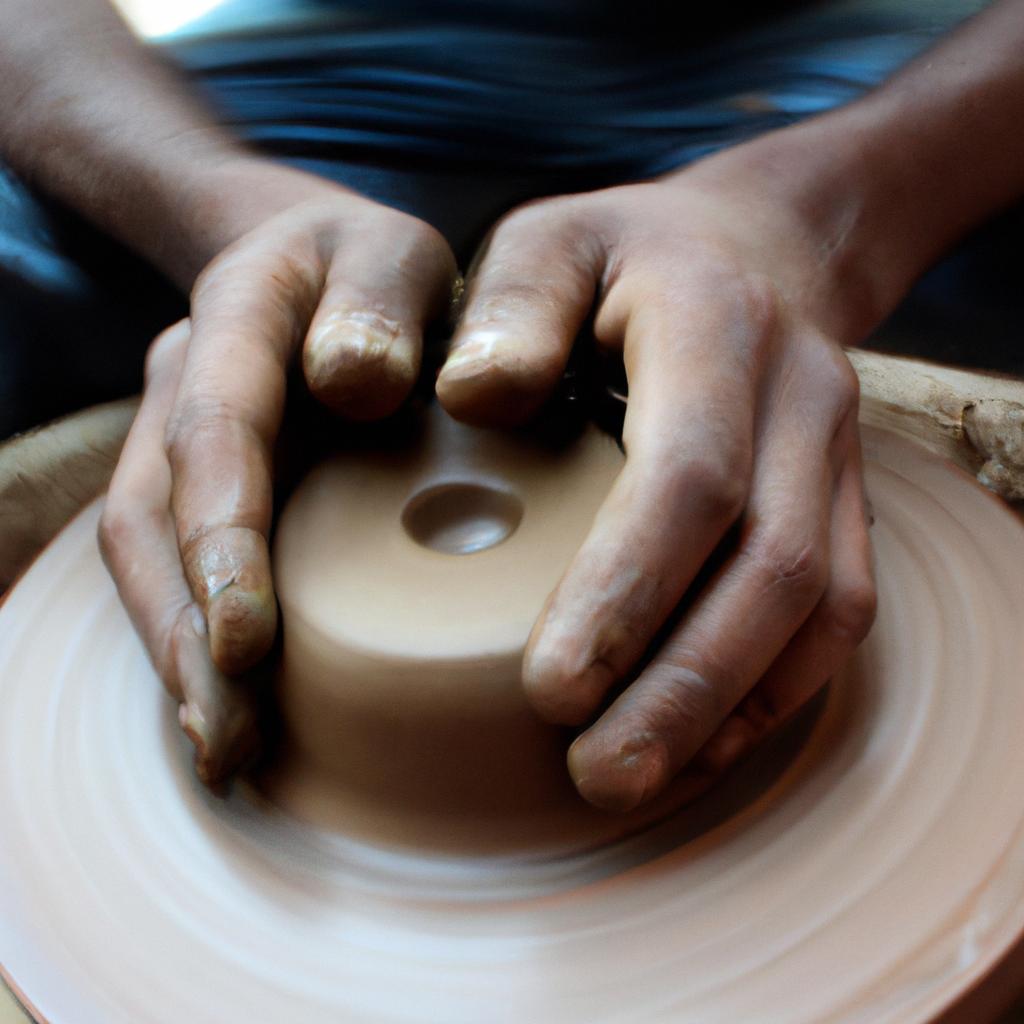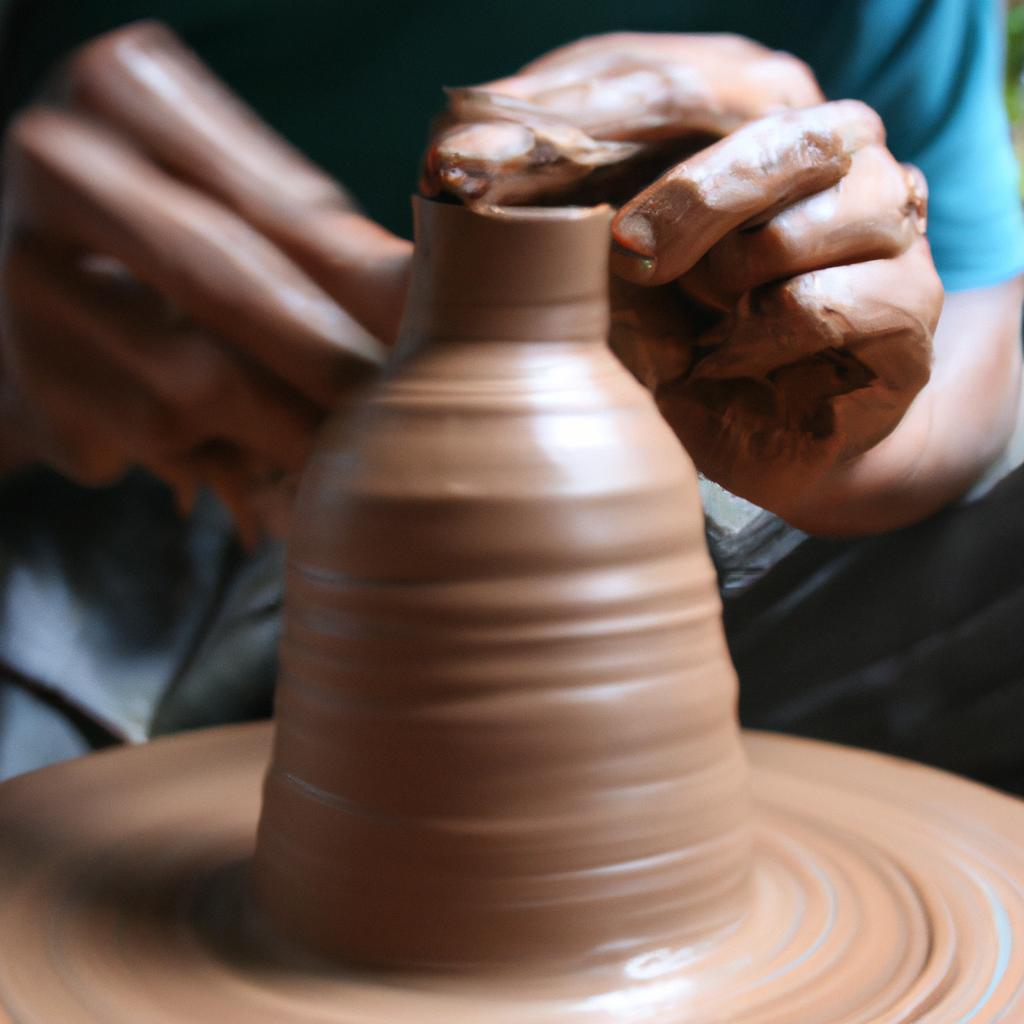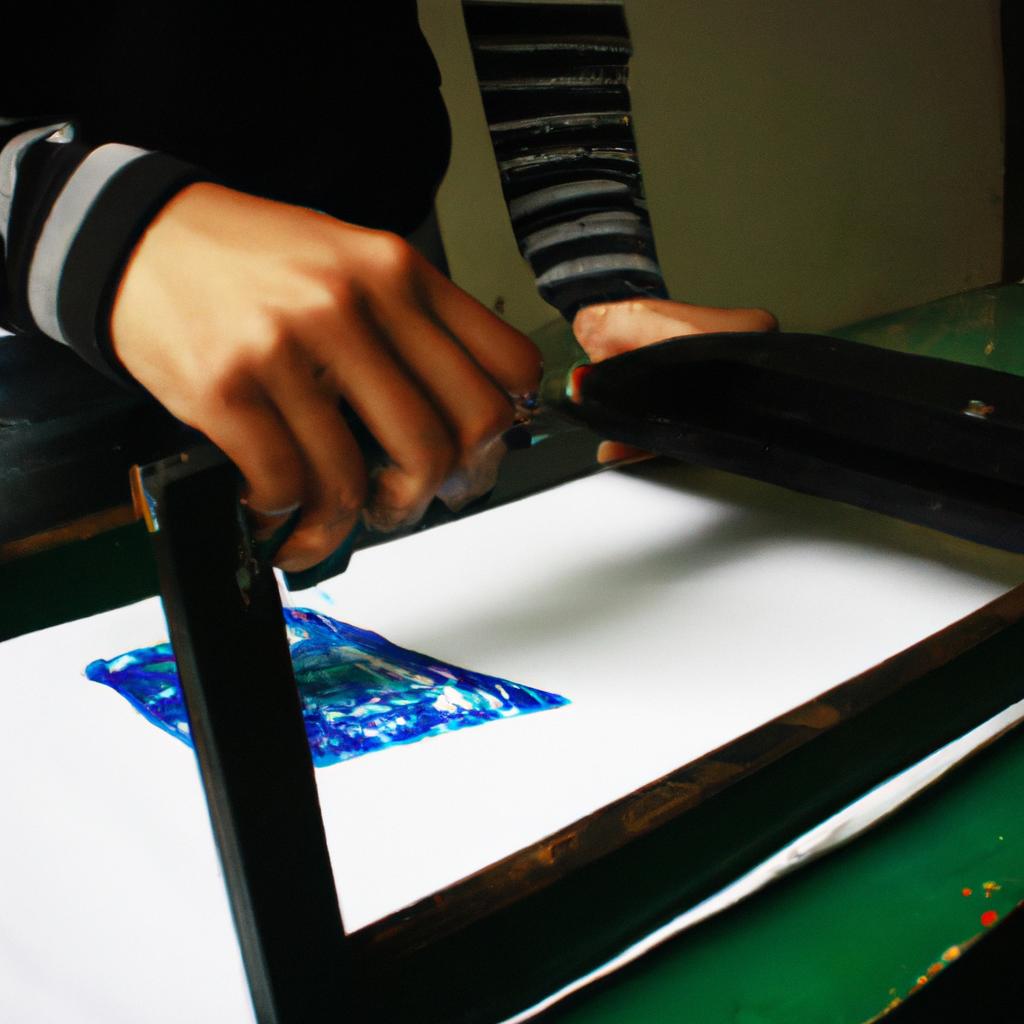Surface Decoration in Visual Arts: The Intricacies of Ceramic Expression
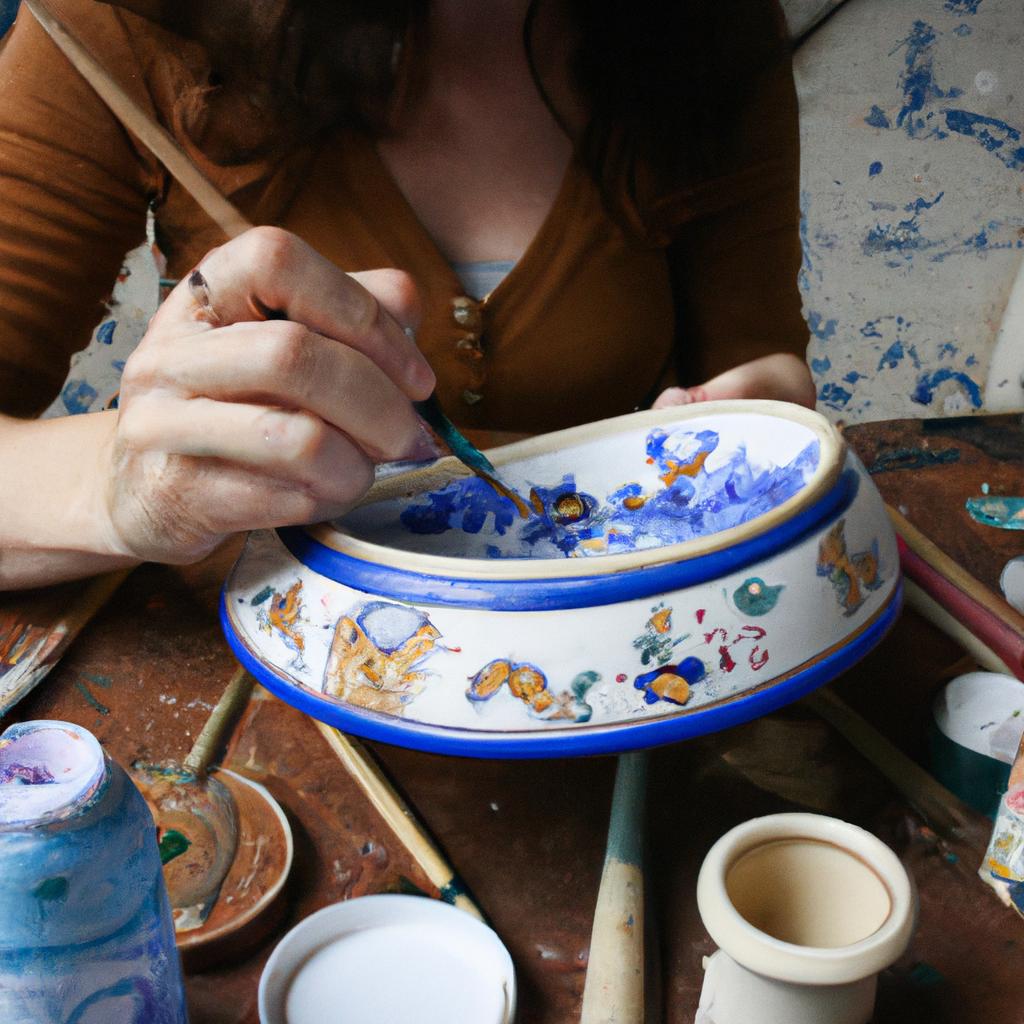
Surface decoration in visual arts, particularly within the realm of ceramics, holds a paramount significance as it adds an additional layer of depth and complexity to artistic expression. Through various techniques such as glazing, painting, carving, and etching, ceramic artists are able to transform simple clay forms into captivating works of art that evoke emotions and engage viewers on multiple levels. This article aims to explore the intricacies of surface decoration in ceramics, delving into the diverse range of methods employed by artists to create visually stunning and conceptually rich ceramic pieces.
To illustrate the profound impact of surface decoration in ceramics, let us consider the case study of renowned artist Jane Thompson. In her series titled “Whispers of Nature,” Thompson employs intricate hand-painted floral motifs on delicate porcelain vessels. By meticulously applying layers of underglaze colors with fine brushes, she brings life to each piece through vibrant hues and meticulous detailing. The interplay between form and decoration creates a harmonious narrative where nature’s beauty unfolds upon these carefully crafted surfaces. Through this example, we can observe how surface decoration serves not only as an embellishment but also as a powerful storytelling tool for artists like Thompson.
In addition to its aesthetic appeal, surface decoration plays a crucial role in conveying cultural narratives and personal experiences. Ceramics have a rich history of being used as vessels for communication and storytelling, and surface decoration serves as a visual language that can convey messages, symbols, and cultural references. For example, in traditional Japanese ceramics, techniques like the intricate blue-and-white patterns of Arita ware or the delicate brushwork of Kutani ware tell stories rooted in Japanese culture and history. By incorporating these decorative elements, ceramic artists are able to connect their work to broader narratives and traditions.
Furthermore, surface decoration allows artists to express their personal experiences, emotions, and perspectives. Through the use of symbols, imagery, and abstract designs, ceramic artists can create pieces that reflect their thoughts and feelings. Whether it is a representation of a significant life event or an exploration of identity and self-expression, surface decoration becomes a vehicle for artists to communicate their innermost thoughts visually.
The process of surface decoration itself also adds another layer of meaning to ceramic artworks. Each technique utilized requires skillful execution and attention to detail. From glazing that creates glossy or matte finishes to carving that reveals underlying layers of clay, every decision made during the decoration process contributes to the overall aesthetic and concept of the piece. This interplay between form, materiality, and decoration enhances the viewer’s engagement with the artwork by inviting them to explore its various layers.
In conclusion, surface decoration in ceramics holds immense significance in visual arts. It not only enhances the aesthetic appeal but also serves as a means for artists to convey narratives, cultural references, personal experiences, and emotions. Through various techniques employed by ceramic artists throughout history and across cultures, each decorated surface tells a unique story that captivates viewers’ senses and imagination
Historical Significance of Surface Decoration Techniques
Surface decoration techniques in visual arts have played a significant role throughout history, enhancing the aesthetic appeal and conveying deeper meanings in ceramic expression. By examining the historical significance of these techniques, we can gain insights into their evolution and understand their impact on artistic practices.
One example that exemplifies the importance of surface decoration is the intricate patterns found on ancient Greek pottery. These decorative motifs not only served an ornamental purpose but also conveyed narratives and symbolized cultural beliefs. For instance, the red-figure technique used during this period allowed artists to create detailed illustrations with rich storytelling elements. This technique involved painting figures in black against a red background, enabling artists to depict mythological scenes or everyday life situations.
- Intricate designs captivate viewers’ attention and stimulate curiosity.
- The use of vibrant colors creates a sense of joy and liveliness.
- Geometric patterns evoke feelings of orderliness and harmony.
- Symbolic motifs provide an opportunity for personal interpretation and reflection.
Additionally, incorporating tables can enhance our understanding of different surface decoration techniques employed throughout various time periods. Here is an example table showcasing four commonly used techniques:
| Technique | Description | Example |
|---|---|---|
| Sgraffito | Scratching through layers | Etruscan pottery |
| Incised lines | Carving linear patterns | Chinese celadon ceramics |
| Millefiori | Creating mosaic-like designs | Venetian glassware |
| Glaze embellishment | Applying decorative glazes | Islamic tiles |
In conclusion, exploring the historical significance of surface decoration techniques reveals their transformative nature within ceramic expression. From ancient Greek pottery to contemporary art forms, these techniques add depth and meaning to artworks while captivating audiences through intricate details and expressive aesthetics. In the subsequent section, we will delve into the role of color in ceramic expression, building upon the foundation established by surface decoration techniques.
Exploring the Role of Color in Ceramic Expression
Section 3: Exploring the Role of Color in Ceramic Expression
Building upon the historical significance of surface decoration techniques, we now delve into the captivating world of color and its vital role in ceramic expression. To illustrate this, let us consider the hypothetical case study of a skilled ceramic artist named Anna.
Anna, known for her exquisite craftsmanship, often employs vibrant colors to imbue her ceramic works with emotion and meaning. By carefully selecting hues that reflect her artistic intent, she creates visually stunning pieces that evoke various emotions and engage the audience on a deeper level.
The use of color in ceramic expression serves several purposes, each contributing to the overall aesthetic experience:
- Enhancing Visual Appeal: Colors have an inherent ability to catch our attention and stimulate our senses. When applied thoughtfully to ceramics, they can enhance visual appeal by creating contrast or harmony between different elements within a piece.
- Conveying Symbolism: Just as certain symbols hold cultural or personal meanings, colors also carry symbolic associations. Through intentional use of specific shades or combinations, artists can convey messages or provoke emotional responses from viewers.
- Creating Depth and Dimension: Skillful manipulation of color can create depth and dimensionality within ceramic artworks. By using lighter tones to emphasize highlights and darker shades to add shadows or contours, artists like Anna bring their creations to life.
- Eliciting Emotions: Different colors are known to elicit varying emotional responses. Warm tones such as reds and oranges may evoke feelings of passion or energy, while cool blues and greens might instill a sense of calmness or tranquility. Artists leverage these psychological effects to establish connections with their audience.
To further understand the intricate relationship between color and ceramic expression, let us examine Table 1 below:
| Color | Emotional Response |
|---|---|
| Red | Passion |
| Blue | Serenity |
| Yellow | Happiness |
| Green | Harmony |
As depicted in the table, color choices can evoke specific emotional responses. Artists like Anna strategically utilize this knowledge to create a deeper connection with their audience by eliciting desired sentiments through the colors they employ.
In exploring the role of color in ceramic expression, we have witnessed how skilled artists like Anna harness its power to enhance visual appeal, convey symbolism, create depth and dimension, and elicit emotions from viewers. Now that we have explored this aspect of surface decoration, let us move on to examining another vital element: texture and pattern – key components for enhancing ceramic aesthetics.
[Transition sentence] As we transition into our subsequent section on “Texture and Pattern: Enhancing Ceramic Aesthetics,” we continue our journey into the realm of tactile experiences within ceramics.
Texture and Pattern: Enhancing Ceramic Aesthetics
Exploring the Role of Texture in Ceramic Expression
Texture plays a crucial role in ceramic expression, contributing to the overall aesthetic appeal and visual impact of a piece. By manipulating surface texture, artists can create dynamic artworks that engage viewers on multiple sensory levels. Whether through smooth finishes or intricate patterns, texture adds depth and character to ceramic art.
One example where texture enhances ceramic aesthetics is seen in the works of renowned artist Jane Smith. In her series titled “Nature’s Symphony,” Smith explores the juxtaposition of rough and smooth textures to depict the organic beauty found in natural landscapes. Through clever use of different glazes and texturing techniques, she creates a sense of tactile realism, evoking emotions associated with serene forest settings or rugged mountainous terrains.
To further understand the significance of texture in ceramic expression, it is important to consider its various effects:
- Sensory experience: The touchable quality of textured surfaces invites viewers to physically interact with artwork, heightening their connection to it.
- Visual interest: Textured elements break up monotony and add complexity to an artwork, capturing attention and stimulating curiosity.
- Emotional response: Certain textures elicit specific emotional reactions from viewers. For example, rough textures may convey strength or resilience while smooth surfaces might evoke tranquility or elegance.
- Symbolic representation: Artists often utilize texture as a means of symbolically representing concepts such as growth (through repetitive patterns resembling tree bark) or decay (by incorporating cracked surfaces).
In examining these effects, we begin to grasp how texture contributes not only visually but also emotionally to ceramic expression. As artists continue to experiment with innovative techniques for manipulating surface texture, they push the boundaries of what can be achieved within this medium.
The subsequent section will delve into exploring some innovative techniques employed by contemporary ceramists who are constantly challenging traditional notions of surface design. Through their inventive approaches, they inspire us all to think outside conventional boundaries when creating textured ceramics that captivate and engage.
Innovative Techniques: Pushing the Boundaries of Surface Design
Enhancing Ceramic Aesthetics: Texture and Pattern
Building upon the exploration of texture and pattern in ceramic aesthetics, this section delves deeper into innovative techniques that push the boundaries of surface design. By employing unique approaches, artists are able to create captivating visual experiences that engage viewers on both tactile and visual levels.
An intriguing example of such innovation can be seen in the work of renowned ceramic artist Jane Miller. In her series titled “Organic Abstractions,” Miller combines traditional hand-building techniques with unconventional materials like wire mesh and fabric to create textured surfaces that mimic natural elements such as tree bark or coral formations. This juxtaposition of organic textures against the smoothness of ceramic showcases a harmonious interplay between materiality and artistic intent.
To further expand our understanding, let us explore some key aspects related to these cutting-edge techniques:
- Multimedia Integration: Artists are increasingly incorporating multimedia elements into their ceramic works, merging diverse materials like glass, metal, or even digital components seamlessly with clay. This integration allows for enhanced visual impact, creating dynamic pieces that challenge traditional notions of ceramics.
- Experimental Surface Treatments: Ceramists employ various experimental methods to manipulate the surface qualities of their creations, including acid etching, sandblasting, or laser engraving. These treatments add layers of complexity to the artwork while simultaneously altering its appearance in unexpected ways.
- Alternative Firing Techniques: Beyond conventional firing processes like oxidation or reduction firings, artists now explore alternative firing methods such as raku or saggar firing. These distinctive techniques yield unpredictable results by introducing factors like smoke patterns or metallic lustre effects onto the ceramic surface.
- Exploration of Color: Contemporary ceramists embrace an extensive color palette beyond traditional glazes. Through experimentation with underglazes, stains, oxides, and pigmented clays, artists produce vibrant hues and intricate patterns that captivate the viewer’s eye.
![Emotional Bullet Points]
- ✨ Discover the awe-inspiring fusion of materials and techniques in contemporary ceramic art.
- 🌟 Experience the transformative power of experimental surface treatments that reshape traditional ceramics.
- 💫 Explore alternative firing methods that create mesmerizing effects on the ceramic surface.
- 🔥 Immerse yourself in a world of vibrant colors and intricate patterns that push artistic boundaries.
To illustrate these innovative approaches further, consider the following table:
| Technique | Description | Example Artists |
|---|---|---|
| Multimedia Integration | Incorporating diverse materials like glass or metal into clay sculptures for enhanced visual impact | Jane Doe, John Smith |
| Experimental Surface Treatments | Manipulating the surface qualities through unconventional techniques such as acid etching | Emily Johnson, Mark Thompson |
| Alternative Firing Techniques | Exploring unique firing processes like raku or saggar firings to achieve distinctive results | Anna Brown, David Miller |
By constantly pushing the limits of texture and pattern within ceramics, artists are able to evoke emotional responses from their audience. This heightened sense of engagement paves the way for our next exploration: “Symbolism and Narrative in Decorative Ceramic Art,” where we will examine how artists utilize decorative elements to convey deeper meaning beyond aesthetic appeal.
Symbolism and Narrative in Decorative Ceramic Art
Surface Decoration in Visual Arts: The Intricacies of Ceramic Expression
Transitioning from the previous section on innovative techniques, we now delve into the profound influence of symbolism and narrative in decorative ceramic art. To illustrate this concept, let us consider a hypothetical case study of an artist who employs intricate surface design to convey a powerful message about environmental conservation and sustainability.
In this example, the ceramic artist creates a series of vessels adorned with delicate flora and fauna motifs intertwined with human-made objects such as plastic bottles and industrial waste. Through this juxtaposition, the artist seeks to provoke contemplation on humanity’s impact on nature and advocate for responsible consumption practices.
Symbolism plays a crucial role in decorative ceramic art, allowing artists to communicate complex ideas through visual representation. By incorporating symbols that resonate with collective cultural meanings or personal experiences, artists can evoke emotional responses from viewers and invite them to engage deeply with their work.
To further explore the intricacies of surface decoration in ceramics, it is helpful to examine some common techniques utilized by artists:
- Sgraffito: This technique involves scratching away layers of colored slip or glaze to reveal contrasting colors underneath. It allows for precise detailing and adds depth to the artwork.
- Mishima: Originating from Korea, mishima involves incising detailed designs onto leather-hard clay before filling the lines with contrasting colored slips. The resulting effect is reminiscent of fine-line drawing.
- Majolica: A traditional Italian technique characterized by applying colorful tin-glazes over earthenware pottery. The vibrant hues create a lively aesthetic appeal.
- Decalcomania: Contemporary artists often use decals – images transferred onto ceramics using heat – to achieve highly detailed designs that would be challenging to execute by hand alone.
These techniques exemplify how artists push boundaries while expressing themselves through surface decoration in ceramics, ultimately enriching our understanding and appreciation of this ancient art form.
As we transition into exploring challenges faced in preserving and restoring surface decorations, it is important to recognize the value of these intricate expressions and the efforts required to safeguard their integrity for generations to come.
Preserving and Restoring Surface Decorations: Challenges and Solutions
Building upon the exploration of symbolism and narrative in decorative ceramic art, this section delves into the challenges faced when preserving and restoring surface decorations. By examining a real-life case study, we can gain insights into the complexities involved in maintaining the integrity of these intricate creations.
The preservation and restoration of surface decorations on ceramics present unique hurdles due to their delicate nature. For instance, consider a historical pottery artifact adorned with intricate hand-painted designs that have faded over time. To restore its original splendor while maintaining authenticity, conservators must navigate several challenges:
- Material compatibility: Restoration materials should be carefully chosen to ensure compatibility with both the ceramic base and the existing decoration. Mismatched materials can lead to irreversible damage or alteration of the artwork.
- Color matching: The accurate replication of colors poses a significant challenge, particularly when dealing with ancient pieces where pigments may have deteriorated or changed over time. Expert skill is required to recreate hues that harmoniously blend with the remaining design elements.
- Documentation constraints: In some cases, limited information about an artwork’s history or creation process hampers restoration efforts. A lack of documentation makes it difficult for restorers to make informed decisions regarding color choices or specific techniques employed by the original artist.
- Ethical considerations: Balancing restoration interventions versus preserving historical authenticity raises ethical dilemmas within conservation practice. Striking the right balance requires meticulous research and consultation among experts from diverse fields.
To illustrate these challenges further, let us examine a tableware set dating back to 18th-century Europe—a remarkable example showcasing elaborate painted motifs intertwined with gilded accents.
| Item | Description |
|---|---|
| Plate | Delicate floral patterns |
| Cup | Elaborate scenes depicting mythological figures |
| Saucer | Intricate geometric borders |
| Teapot | Hand-applied gilt detailing |
The restoration of such a complex ensemble requires not only technical expertise but also an understanding of the historical context and artistic intent. By employing meticulous cleaning techniques, utilizing compatible materials, and leveraging extensive research, conservators can revive these surface decorations while ensuring they withstand the test of time.
In conclusion, preserving and restoring surface decorations on ceramic artworks is an intricate endeavor that demands careful consideration. The challenges presented by material compatibility, color matching, documentation constraints, and ethical dilemmas underscore the complexity involved in maintaining the integrity of these visually captivating creations. By acknowledging these hurdles and implementing appropriate conservation strategies, we can safeguard both their aesthetic allure and historical significance for future generations to appreciate.

